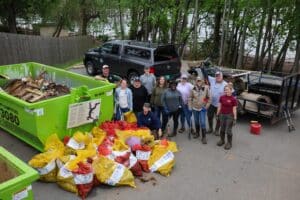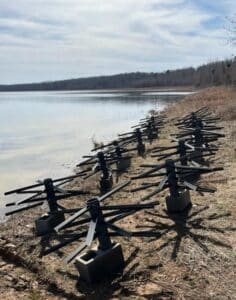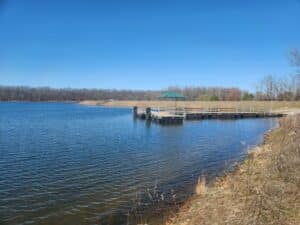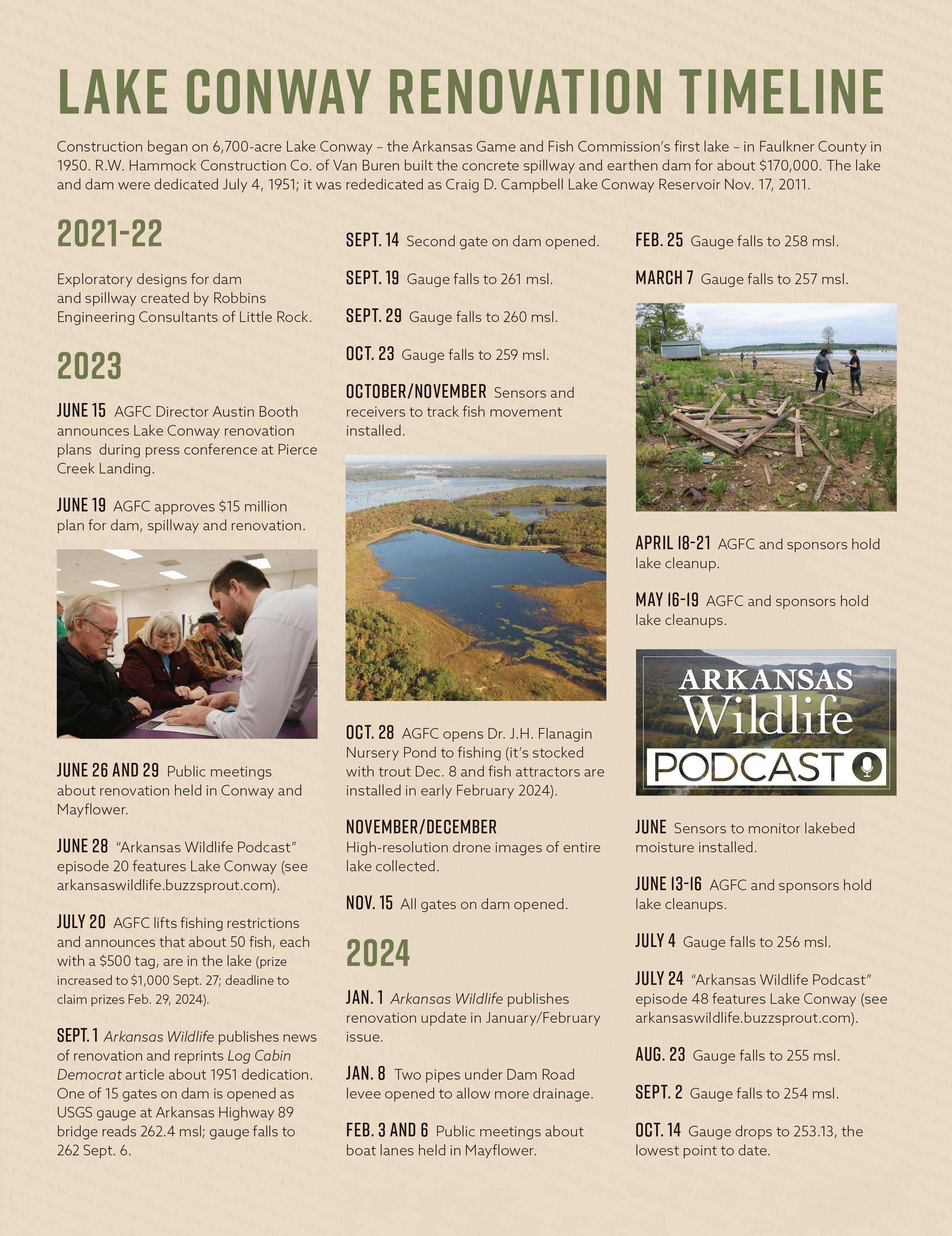Lake Conway Renovation Project
Latest Lake Conway Updates:
- February 15: Gravel work is now complete in the Pierce Creek and Caney Creek arms. This will improve sunfish reproduction as well as sites for anglers to target sunfish. 600 cypress trees have been planted throughout the lake, and 80 lean-to structures have been completed. Most of this effort was done in the Pierce Creek and Dix Creek areas. The lean-to structures should attract crappie, bass and catfish and were designed with fishability in mind. The hardwood used for construction should make these viable sites for much longer than a standard brush pile.
- August 20: As the weather cools off, we’d like to remind visitors to the lake that searching for artifacts on the lakebed is prohibited. Deer hunting with modern guns and alternative firearms also is not allowed in the lakebed during the drawdown.
- June 24: Lake Conway has reached a new low water level; the lake bed will be drier than it has been and will begin to look visually different.
- June 13-15: AGFC hosted one last organized public cleanup of the shoreline. So far, 36 tons of litter and roughly 20 tons of tires have been removed from the lakebed.
- May 16-18: AGFC hosted additional community-wide cleanups for Lake Conway.
- April 18-21: AGFC hosted four community-wide cleanups for Lake Conway to help pick up litter along the lake. Dumpsters were provided, and many pounds of trash were successfully removed from the lake.

- Feb 26: Improvements continue at the Lake Conway Nursery Pond. Over the last two weeks AGFC sank over 50 habitat structures and fish feeders were installed and operating. Folks are catching trout at a good clip. It will take some time for the fish to get “trained” on the feeders.


- During the week of Feb. 18-24, contractors completed drone imagery work.
- On Feb. 3 and 6, public meetings were held in Mayflower to discuss where boat lanes could be created, moved, or improved for Lake Conway.
- On Jan. 9, additional relief pipes were opened.
- On Dec. 8, Lake Conway’s Nursery Pond was stocked with trout.
- On Nov. 15, all operational gates at Lake Conway Dam were opened. Click here for more information.
- On Oct. 28, Lake Conway’s Nursery Pond was opened to rod-and-reel angling and was stocked with crappie, catfish, bass and bream for anglers. Statewide creel limits apply to the nursery pond during the renovation. Click here for more information.
- On Sept. 14, the second gate at the Lake Conway dam was opened.
- On Sept. 1, 2023, the first gate at the Lake Conway dam was opened.
Rebuilding a Legend: AGFC Renovating Lake Conway in Central Arkansas
Lake Conway was built in 1948, and at the time was the largest lake ever constructed by a state wildlife agency. Now, after 75 years, this central Arkansas treasure is in need of rehabilitation.
The gates and spillway structure of this lake have long passed their useful life expectancy and the Arkansas Game and Fish Commission is beginning to see failures at an increased rate, requiring multiple repairs within the last few years. Additionally, this structure requires manual operation of gates to maintain water levels in the lake during rain events.
Increased engineering knowledge and technology during the last 75 years has made it possible to replace the old gate system with a new design that will allow water to be released instantaneously over a spillway and accommodate rising lake levels. This eliminates the need to manually raise and lower gates to regulate different flows of water and eliminates moving parts that require maintenance.
With the new spillway, the need for the annual winter drawdown to accommodate heavier rainfall will be eliminated, allowing the use of much more lake area from November through March.
The replacement of the water-control structure offers the Arkansas Game and Fish Commission a prime opportunity to enhance Lake Conway and prepare the lake for another 75 years of fantastic fishing opportunities in the heart of Central Arkansas. However, it will require the lake to be drawn down completely and remain dry for up to five years to complete all aspects of the proposed renovation.
The recently completed renovation of 341-acre Lake Poinsett near Harrisburg currently stands as the largest-scale complete lake renovation the AGFC has completed in its 109-year history. The proposed renovation of the 6,700-acre Lake Conway will eclipse that mark and stands to be one of the largest fisheries projects the agency has embarked upon since the same lake was originally created.
Benefits of an Extended Drawdown
Massive amounts of silt and sediment have built up on the lake’s bottom during the last 75 years. Completely natural in many fertile fisheries, this byproduct of aging has taken away as much as 3 feet of depth in portions of the lake and smothered much of the lake’s prime fish spawning habitat. Many boat house owners in the northern quarter of the lake cannot access their boathouse by water any longer because of this buildup.
An extended drawdown will allow the lakebed to dry out and compact, regaining as much as 1 ½ feet of depth in some locations. Once exposed to air, organic matter trapped in the sediment will decompose and be recycled into the system through the growth of grasses, vines and other vegetation.
Drying of the lakebed and compaction of the silt also will promote more hard bottom areas and vegetation that is used by fish for spawning habitat. While the lake is full of stumps, more complex cover offered in natural woody vegetation serves much better as shelter for baitfish and young sportfish. Additionally cypress trees that still live in the lake’s water should see a boost in growth from the temporary reprieve from flooding. This growth also will offer much more complex cover for fish than bare trunks and root systems.
Clean Slate
Lake Conway is in a very productive watershed, but the loss of spawning habitat and lake depth prevent the lake from living up to its true potential. This fertility has led to a large amount of nontarget “rough” fish such as gar, buffalo and bowfin in the lake. The 2019 flood of the Arkansas River may have intensified this problem when the river flowed backward over the gates of the current spillway and allowed an open door to more rough fish, which may have included invasive carp species. Few new reservoirs are being built, both in Arkansas and across the country, so drawdowns for renovations provide a rare opportunity for biologists to hit the “reset” button on a fishery. Draining the lake will enable the AGFC to start with a clean slate and focus as much of the lake’s nutrients as possible toward desirable species. The lake’s fertility will then allow the fish to grow quickly, promoting a fast recovery post-renovation.
Creating Cover
Natural cover won’t be the only thing building momentum in the lakebed. The AGFC plans to intensify complex cover for fish in key areas of the lake, which includes such actions as adding gravel spawning beds to increase productivity for bream and other sunfish, planting additional cypress trees to create more cover and building artificial structures and brush piles.
A similar project was recently completed at Lake Poinsett in northeast Arkansas. During that renovation, 174 habitat sites were established in the 341-acre lake. AGFC plans to match that density of fish habitat sites in Lake Conway, which would bring the total to well over 3,000 fish attractor locations in the lake once the renovation is complete.
Access Increases
The renovation also will enable fisheries personnel to work on additional infrastructure projects to make the fishing experience even better for Lake Conway anglers. Establishment of boating lanes through Conway’s stump-filled waters will be a priority for staff when water and soil conditions allow. Staff also will continue replacing the older steel boat lane markers with higher visibility markers for increased navigation safety. Increased ease of boating will enable Lake Conway to be much more attractive to anglers who formerly wrote off this fishery as “Old Stumpy.”
Boat ramps also will be improved as the AGFC will work to dredge channels near the ramps, enhancing access points. Additional launching and parking capacity at a few current facilities are planned, and more improvements may be possible with additional funding.
In addition to adding boat launching facilities, the drawdown will allow the AGFC to increase angling opportunities for bank anglers by improving existing bank fishing accesses and exploring additional opportunities to access the lake shore by foot.
Cleaning the Shoreline
AGFC staff also plan to remove many structures that have fallen in a state of disrepair that are on state-owned property during the drawdown. Many boathouses and piers that have been abandoned or left unmaintained by former landowners, creating safety hazards around the lake’s perimeter will be demolished and usable materials will be incorporated into new fish attractors.
The cleanup not only will take place along the shore, but also among the thousands of trees filling the lake. Workers will be able to remove decades of passive fishing devices and illegally placed metal stakes in the lakebed that have accumulated over the years.
Stay Updated
To subscribe to text updates on the Lake Conway improvement project, text CONWAY to 56548. Message fees and data rates may apply depending on your service provider.
For more information on the economic and recreational impacts this project will have in the surrounding communities, visit NewLakeConway.com.
You can also revisit this page at your convenience for updates during the course of the project.

